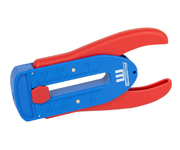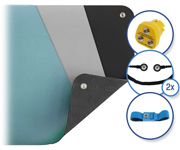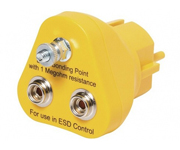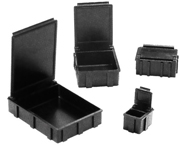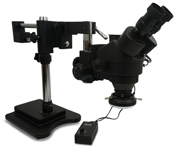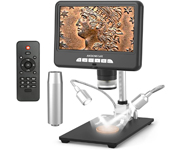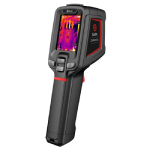Soldering is the joining of two metals using a third metal (soldering tin). This joining method is used in almost all electrical applications to make an electrical and mechanical bond. Good soldering is not easy and quite a lot of things are involved. This article explains what it takes to solder 'through hole' and gives a step-by-step plan of how to make a good solder joint.
Not all metals are solderable. There are only a few metals to which solder adheres well. These are gold, silver and copper. Aluminum, chrome and nickel are not or only poorly soldered. If a metal component is difficult to solder, a good solderable layer is applied to it beforehand. For example, a wire can be "tinned" beforehand by holding the soldering point underneath the wire and the soldering tip on the wire. If the wire is warm enough, the solder will flow from far away over the entire surface.
Table of contents
- Soldering tool and soldering tip
- Through-hole soldering
- Soldering rules
- Soldering temperature
- Good and bad solder joints
Soldering tools and soldering tips
The most important tool during hand soldering is the soldering iron. The most important parts of this are the handle, heating element and the tip. The soldering iron is often attached to a , these solutions are much more robust than individual soldering irons. |  |
The heating element is tubular. The is inserted into the tube and thus heated via the heating element. The soldering tip is made of copper. Copper is a metal that conducts heat very well. The soldering tips are easy to replace. The choice for the soldering tip depends on the type of soldering work. For example, the place where to be soldered determines whether the tip should be straight or curved, or short or long. A long pin cools down more quickly; a thick pin retains the heat longer. |  |
Soldering tin
As mentioned earlier, is also very important for connecting the materials. Solder tin has a lower melting point than the two metals to be soldered. The soldering tin which is usually used contains lead and consists of about 63% tin and about 37% lead. This solder melts at 183 °C. Lead-free solder can consist of tin, copper and silver and has a higher melting point (217 °C) than leaded solder and other properties. In addition, a flux (resin) with a small amount of cleaning agent is used in the soldering tin.
Other useful tools
These things are not essential to the process, but they do make it much easier. For example, it is useful to use a third hand, as you will quickly run out of hands when soldering. and are also almost always needed. For good adhesion it is also very important that the pen is clean, for this a drip tray is very useful.
Through-hole soldering
The soldering process takes place in a number of steps that follow each other quickly in practice.
| 1. The soldering tip is placed on the soldering spot. The heat is transferred to the parts to be soldered. 2. Soldering tin is applied at the boundary of the soldering tip and the soldering place |
 |
| 3. Soldering tin reaches the right temperature and flows over the soldering area. This gives an even better heat transfer to the parts. 4. The liquid soldering tin rises up against the parts and covers the solder spot. |  |
| 5. The soldering tip is removed 6. The soldering iron is removed 7. Do not move and allow to cool down. The solder joint solidifies and the joint is ready. |
 |
Soldering rules
| 1. Allow the soldering iron to warm up. | Depending on the type of soldering iron, between 2 seconds (JBC) or about 3 minutes (budget types) is necessary. It makes no sense to start soldering when the soldering tin melts. The soldering iron is then not hot enough to transport enough heat to the parts to be soldered. A good temperature to use as a starting point for leaded tin is 300 - 330°C, for lead-free tin, these temperatures are about 20 degrees higher. |
| 2. Remove the excess sprouting material, first cut then solder. | This removal must be done before soldering, otherwise the soldering may be damaged. Often the solder is first soldered and then cut. This way looks easy but damages the connection. After all, a great deal of force is exerted on the joint. In addition, a piece of bare copper is formed at the cutting edge (oxidation). |
| 3. Clean the adhering oxidized solder tip with a damp sponge. | Oxidised solder is a poor conductor, which also contaminates the soldering to be made. Therefore, the soldering tip must be cleaned for each series of solders to be made. The sponge must be moist, but not really wet. Otherwise the temperature of the tip will drop too much. |
| 4. Place the soldering tip against the heaviest part to be soldered. | Since the heaviest part to be soldered will absorb the most heat, it should be heated first. |
| 5. Melt a small amount of soldering tin between the soldering point and the soldering place. | Men calls this "building a bridge". The purpose of this bridge is to speed up the transport of heat. This is necessary in order not to exceed the maximum soldering time. |
| 6. Solder within 3 seconds, | If soldering takes longer, the risk of irreparable damage to the component increases. |
| 7. Apply the right amount of solder on the opposite side to make the actual soldering. | Now the actual soldering is made: - Keep the soldering point in the same place, - The temperature at the soldering point has risen, - Solder tin can be added at this time. When adding the soldering tin, make sure that the tin does not come into direct contact with the tip of the soldering iron. The tin must melt between the conductors. |
| 8. Take away the soldering tin, but give the soldering time to flow through. | The soldering tin is now removed, but leave the soldering iron in the soldering place for a while. This gives the soldering time to pull up. We call this "flowing through". Make sure that during the solidification of the tin-plated connected parts do not move relative to each other. |
Soldering temperature
The soldering iron is kept at a fixed temperature by means of an electronic control. However, the temperature of the tip changes during soldering, especially in systems with passive points. As discussed, the soldering point temperature is higher than the melting temperature of the solder. This is necessary because first the parts to be connected have to be heated. After all, you can not solder to cold conductors. The extra heat stored at the soldering point is therefore used to heat the parts to be joined. This means that the initial temperature (e.g. 330 °C), during the soldering process, will drop to (depending on the weight of the joint) approximately 260 °C. This value is called the actual working temperature. |  |
After making the soldering, the tip temperature will rise again to the original value (330°C or 350°C) and the soldering process can start again. This variation in temperature is called the soldering iron cycle. In the article about active and passive points this subject is explained in more detail.
Good and bad solder joints
A good solder connection provides:
- A good adhesion between the components to be connected.
- A good electrical connection (good electrical contact)
- A good mechanical connection (the components are firmly attached)
- Reliability and durability of the product
 |  |
| Good solder joint | Bad solder joint |
With this information you can make a start in the world of soldering. For hobbyists this can provide enough information to solder PCBs, but the most important thing with soldering is practice.







